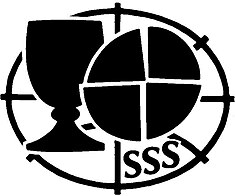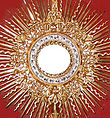Congregation of the Blessed Sacrament
| Societas Sanctissimi Sacramenti | |
 | |
| Abbreviation | S.S.S., Sacramentine |
|---|---|
| Formation | 13 May 1856 |
| Type | Catholic religious order |
| Headquarters | Via G. B. De Rossi 46, 00161 Rome, Italy, General Curia (administration) |
| Location |
|
| Coordinates | 41°55′01.8″N 12°31′04.5″E / 41.917167°N 12.517917°E |
Superior General of the Congregation of The Blessed Sacrament | Very Rev. Eugênio Barbosa Martins, S.S.S. |
Key people | Peter Julian Eymard Lodovico Longari Giovanni Nadiani |
Main organ | General Curia |
| Website | sssinternational |
The Congregation of the Blessed Sacrament (S.S.S.) is a Catholic religious congregation of priests, deacons, and brothers founded by St. Peter Julian Eymard. By their life and activities, they assist the Church in her efforts to form Christian communities whose center of life is the Eucharist. They commit themselves to the implementation of this ideal in collaboration with lay men and women engaged in various ministries.
History
The Congregation of the Blessed Sacrament, whose name in Latin is Societas Sanctissimi Sacramenti, was founded in Paris, France, on May 13, 1856, by a French priest, Saint Peter Julian Eymard. As he searched for response to the needs and challenges of his time, he found the answer in the love of God manifested in a special way in the Eucharist. During Eymard’s lifetime, the character of French Catholicism was changing from a religion of guilt and fear to a religion based on God’s mercy and love. Eymard was a leading figure in this transition.[1]
Founder – St. Peter Julian Eymard

Eymard was born February 4, 1811, at La Mure, Isère, France. He was a contemporary and a friend of Peter Chanel, John Vianney, Marcellin Champagnat, and the sculptor, Auguste Rodin. On July 20, 1834, Eymard was ordained a priest for the Diocese of Grenoble, and in 1839, he joined the Marist Fathers. He worked with the Third Order of Mary and other lay organizations promoting devotion to the Blessed Virgin Mary and to the Eucharist, particularly the Forty Hours Devotion.
Eymard became familiar with the practice of sustained eucharistic worship during a visit to Paris in 1849, when he met with members of the Association of Nocturnal Adorers who had established exposition and perpetual adoration of the Blessed Sacrament at the Basilica of Our Lady of Victories.[1] In 1856, Eymard left the Marist order and founded the Congregation of the Blessed Sacrament for men, and, in 1858, together with Marguerite Guillot the Servants of the Blessed Sacrament, a contemplative congregation for women.
Eymard died on August 1, 1868.[2] He was declared venerable in 1908, beatified in 1925, and canonized by Pope John XXIII on December 9, 1962. His feast day is celebrated in the Roman Catholic Church on August 2. He was named Apostle of the Eucharist.
On May 13, 1856 Eymard received permission from the Paris bishops to establish the Blessed Sacrament Congregation. The first community established at 114 rue d’Enfer, Paris.[1]
The Congregation of the Blessed Sacrament began working with children in Paris to prepare them to receive their First Communion. It also reached out to non-practicing Catholics, inviting them to repent and begin receiving Communion again. In 1859 he opened a second community at Marseilles and placed in charge of it his first companion, Fr. Raymond De Cuers. A third foundation was established at Antwerp; then two others at Brussels and a formation house for the novitiate at Saint Maurice in the diocese of Versailles.[2]
Eucharistic Charism
Believing that Christ in the Eucharist has the power to effect a radical transformation in our society and in all people. The power of the Eucharist motivates and strengthens everyone to work for the establishment of Christ's Kingdom on earth. Each religious proclaims the reality of God's love in the Eucharist by his "gift of self" to Him and his brothers and sisters. By prayer in the presence of the Blessed Sacrament and an active apostolic life, he strives to make Christ in the Eucharist better known and loved.
Eymard was a tireless proponent of frequent Holy Communion, an idea given more authoritative backing by Pope Pius X in 1905.
Mission
| Part of a series on |
| Eucharistic adoration of the Catholic Church |
|---|
 |
| Papal documents |
| Organisations and events |
| Notable individuals |
| Eucharistic meditators |
|
|
Following in the footsteps of Father Eymard, the mission of the Congregation of the Blessed Sacrament is to respond to the hungers of the human family with the riches of God's love manifested in the Eucharist.Rule 3, Rule of Life of the SSS[3]
Conscious of a call to bear prophetic witness to the Eucharist, members of the Congregation commit themselves to the renewal of Church and society through this sacrament, especially by gathering communities characterized by hospitality, reconciliation, and service; and celebrating the Eucharist as the source and summit of the life of the Church; ...[4]
By our life and activities, we share in the mission of the Church, so that the Eucharist may be celebrated in truth, that the faithful may grow in their communion with the Lord through Eucharistic adoration in the setting of solemn exposition, that they may commit themselves to the renewal of their Christian communities, and collaborate in liberating individuals and society from the forces of evil.
United in Spirit with those who are poor and weak, we oppose everything which degrades human dignity and we proclaim a more just and brotherly world as we await the coming of the Lord
The Congregation Today
Since its founding, the members of the congregation have reached all continents of the globe and continue the mission begun by St. Peter Julian Eymard. Currently numbering a little less than a thousand religious, they are present in thirty different countries throughout the world.
See also
References
- ^ a b c "Our Story", Blessed Sacrament Congregation, Province of the Holy Spirit, Australia
- ^ a b Fumigalli, S.S.S., Flavio. "A Short Reflection on the Spirituality of Saint Peter Julian Eymard", Blessed Sacrament Religious - Europe
- ^ Congregation of the Blessed Sacrament, Cleveland, Ohio
- ^ "Mission", Blessed Sacrament Religious - Europe

